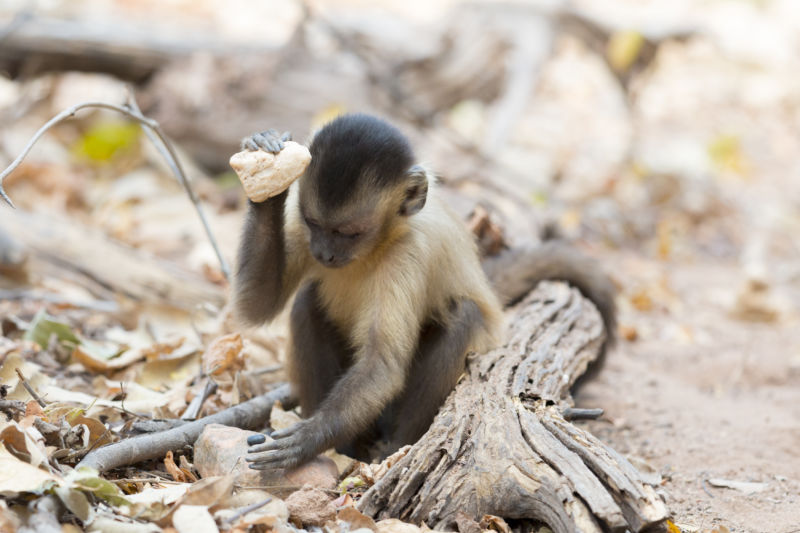
The archaeological record of human tools use dates back about 2.5 million years, and archaeologists use changes in stone tool technology to trace changes in human evolution, culture, and lifestyles. Now a team of archaeologists in Brazil has excavated capuchin monkey stone tools dating back to 3,000 years ago, and they reveal changes in behavior and diet over thousands of years—just like the early human archaeological record but on a compressed time scale.
Archaeology: Not just for humans
Bearded capuchin monkeys are more versatile tool-users than chimpanzees. They select rocks of the right sizes and shapes for a variety of tasks, from digging to cracking open a range of nuts and seeds (each has its own size and weight specifications for the perfect cracking tool). Female capuchins even flirt with potential mates by throwing rocks at them.
At Brazil’s Serra de Capivara National Park, a group of capuchins crack open cashews with round quartzite cobbles, which they choose and carry to the cashew grove from a dry streambed about 25m (82 feet) away. Capuchins have been processing their food at the same spot for at least 3,000 years—and leaving behind their distinctively banged-up tools. That’s about 450 monkey generations, and during that time, archaeologists noticed some major changes in the stone hammers and how they were used.
Changes in the size of the stones, the patterns of damage, and whether the monkeys used other stones as anvils—all of them probably point to changes in how the monkeys were making a living. It’s the first time archaeologists have been able to use tools to track changes in behavior over time for another species. The chimpanzee archaeological record runs for a comparable length of time, but the types of stone tools chimpanzees use, and how they use them, don’t seem to have changed much over that period. Archaeologists haven’t found long enough records for sea otters or long-tailed macaques.
3,000 years of monkeying around
Stone hammers from the deepest layers at the site, which date to 3,000 to 2,400 years ago, are smaller, lighter, and a lot more banged-up than the ones capuchins use and discard today. And stones that would have been used as anvils (which acquire their own signature pattern of dents and dings) are strikingly absent. The most likely explanation is that these ancient monkeys were cracking open smaller, less heavily armored foods than cashews. Seeds wouldn’t require stone anvils, and the smaller targets would make it more likely that stones would damage whatever was underneath the seed.
There’s a break in the record, but when it resumes, in a layer dating from 640 to 565 years ago, it suddenly includes stone anvils alongside the stone hammers. And by 257 years ago, something else changed: the stone hammers from this layer are much larger and heavier than the ones capuchins at the site use today, and anvils (and broken pieces of anvils) are much more common. It looks as if the capuchins had shifted from eating smaller seeds to something even larger and tougher to crack than cashews.
Sometime in the last century, modern capuchin culture emerged. The uppermost layers at the site contain round quartzite (and a few sandstone) cobbles, with patterns of overlapping, conical scars on their flattest surfaces. The newer ones still have smears of recognizable cashew residue, and the cashew trees nearby have battered roots and branches, making it obvious what the tools were used for.
What does it all mean?
Despite their differences, the capuchins’ stone tools at Serra Capivara are all hammers of fundamentally the same type. “While capuchins operated within the same basic stone tool percussive tradition over at least 3,000 years, they implemented this technology to different ends,” wrote University of Sao Paulo primatologist Tiago Falotico and his colleagues.
In our evolutionary lineage, there are major changes in stone tool technology—moving from just banging things with rocks to deliberately shaping sharp edges, for example, or maybe moving from random flaking to using a prepared stone core in a more planned way. These changes usually coincide with big steps in cognitive ability, the emergence of a new species, or a major cultural shift. Smaller changes in the style of tool-making, or the way tools were used, usually signal subtler changes, like a new environment, a new diet, or a change in available tool materials. That’s probably the case with the capuchins.
Because capuchins pass tool use from monkey to monkey (and group to group) through social learning, it’s impossible to say for sure whether their archaeological record is evidence of just one group of monkeys living in the same place and adapting to new foods over thousands of years. It could also be the signature of several different groups who lived here at different times, each with its own hammer-wielding preferences or its own unique diet—culture, in other words.
Falotico and his colleagues say that this 3,000-year capuchin archaeological record offers insights about how tool-using animals adapt to ecological changes in the long run. It also gives us another species to compare with our hominin ancestors’ earliest forays into tool use. That should make us feel a little less alone, but it may also eventually tell us something about our own past.
Nature Ecology and Evolution, 2019. DOI: 10.1038/s41559-0904-4;(About DOIs).
https://arstechnica.com/?p=1526535

